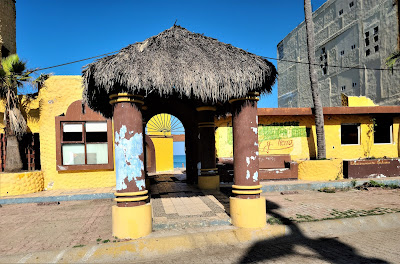Unlike people, all bells are not created equal.
Christmas bells with their promise of social harmony have a far different voice than the ring of the Queen's bell that commands the presence of a servant or the subtle ring of an above-the-door bell in a shop on the high street announcing the possibility of a sale that will entail the far more mercenary sound of the bell in the cash register.
They all sing in the keys of their lives. Johnny One-notes with a purpose.
This morning, while sweeping up the debris from Hurricane Nora on my upper terrace, I heard the distinctive ring of a bell. Not one of the many commercial bells announcing fruits and vegetables or propane for sale. It was different. A sacramental bell -- so out of place in my neighborhood that I froze patiently waiting for it to repeat. It didn't.
Instead, it was followed by the amplified voice of a priest singing a hymn. At first, I thought another religious procession was passing through town. But I was wrong. When I went to my balcony facing the street, I could see that a funeral mass was being performed in front of my neighbor's house. The husband, Lino Salazar Figueroa, had died of a heart attack on the night of the hurricane. Today was a celebration of his life.
I was not surprised when I heard the news that he had died. Last week an ambulance had been called to his house because he had suffered a major heart attack. He was confined to bed on oxygen, and looked as if he was in immense pain. It is one of those situations where we can do little but pray for God's comforting presence.
Señor Salazar was one of the first neighbors I met when I moved to Barra de Navidad in 2014. The empty lot in front of my house has hosted a menagerie of animals since I moved in. A horse. Ducks. Chickens. Turkeys. And others that I cannot recall. Back then, it was goats. Goats that one day would be there and the next they would be in a pot of birria, only to be replace by another goat. And so the cycle went.
Señor Salazar was the ringmaster of them all. He would feed them. Tend them. See that they did not wander too far into the landscaping in front of my house.
He always had a friendly word for me. His extended family lives in several houses on the street. I met most of them through the graces of my golden retriever puppy, Barco Rubio. But Señor Salazar did not need the artifice of a cute puppy to break the cultural ice. We spoke with one another well before Barco showed up.
"Spoke" may be too elaborate of a verb. My Spanish at that time was almost nonexistent. And he had a severe hearing problem. So, our exchanges were primarily in the pleasantries category. No high-falutin' theological discussions for us. And that was fine. A neighborly relationship based on pleasantries is nothing to scoff at.
Today his mass was conducted in front of his home in the presence of his family and friends. Because he had been cremated, his remains were front and center during the celebration of the mass.
Even though I did not know him well, I felt something akin to a rip in the neighborhood fabric because one of us had died. I recently had a conversation with my Mom about medical diagnoses. Her typically unsentimental response has stuck with me. "We are born. We live. We die. That's it."
For my neighbor, Lino Salazar Figueroa, it was the living part that he shared with me that will live on. At least, in the memories of his family, his friends, and also in my own.
For those memories, we thank him.



































